If the crown part of the tooth is destroyed by more than 50%, but the root is intact, it is not at all necessary to remove it. In such cases, in modern dentistry Tooth restoration using a pin has been successfully applied. This technique is actively practiced at the DentaBravo clinic, whose specialists are fluent in all its techniques.
What are pin structures?
These are various rods made of metal or other material that are fixed in root canal and serve as a support for a permanent bridge or artificial crown. The installation of a dental pin is used in cases of significant or complete destruction of the natural crown of the tooth, provided that its root is absolutely healthy.
What types of pin structures are there?
There are therapeutic designs, when the doctor uses standard dental pins, manufactured industrially in a factory, and orthopedic designs - such pins are made individually based on a cast of the patient’s tooth.
When are therapeutic pin structures used?
When reinforcing pulpless, partially destroyed teeth in cases where it is not planned to use an artificial crown. For the restoration of single-rooted teeth in which the pulp has been removed for orthopedic reasons (under metal-ceramic crowns).
What are the disadvantages of therapeutic pin designs?
The main disadvantage is the low strength of the connection between the therapeutic pin structure and the tooth root.
What are the types of therapeutic pins? V and features of their application?
There are several types of dental posts:
- Metal ( anchor pins) made of steel or titanium. They have increased strength and are used in the reconstruction of severely damaged teeth.
- Carbon fiber, glass fiber: the elasticity of these pins is close to the natural elasticity of dentin, thanks to which they give the restoration maximum strength and reduce the risk of root fracture. They are also more aesthetically pleasing and are used to reconstruct anterior teeth.
When are orthopedic pin structures used?
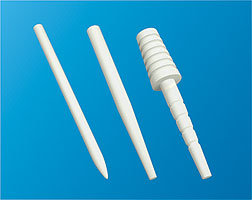 Individual production of a pin structure is indicated if it is necessary to reconstruct the crown due to its complete absence or a severe degree of destruction, that is, in cases where it is necessary to restore the stump and make an artificial crown, as well as when creating a support for a bridge.
Individual production of a pin structure is indicated if it is necessary to reconstruct the crown due to its complete absence or a severe degree of destruction, that is, in cases where it is necessary to restore the stump and make an artificial crown, as well as when creating a support for a bridge.
Advantages of orthopedic pin structures?
Individual orthopedic pin designs are much more reliable than standard pins. Made taking into account all the features of the relief of a particular root, they are perfectly retained in the root canal, and therefore allow you to restore a tooth even in the most difficult cases.
What are the types of orthopedic pin structures and features of their use?
Orthopedic pin structures differ in the material from which they are made, and can be metal or ceramic. The metal construction holds up perfectly heavy loads, therefore used for recovery chewing teeth. Ceramic post structures are more aesthetically pleasing, which is why ceramics are mainly used for restorations in the smile area.
What are collapsible and non-dismountable orthopedic pin structures?
Collapsible structures consist of two individual parts, which are connected during the installation process. As a rule, they are used to restore teeth with two or more roots. Non-separable pins have a monolithic design and are used for the restoration of single-rooted teeth.
What are the quality criteria for pin structures?
The clinical effectiveness of restorations using post structures directly depends on the qualifications of the specialist and the quality of the materials used. At correct execution At all stages of prosthetics there should be no complications, such as decementing of the pin, disruption of the fixation of the artificial stump material, or fracture of the root of the abutment tooth. Pin in tooth also should not cause inflammation of the gums, the presence of recurrent caries of the root and crown parts, progression of bone atrophy in the neck area and other unpleasant phenomena.
What is the cost of pin structures?
It is difficult to give a definite answer to this question, since the price of prosthetics depends on factors such as the degree of tooth destruction and the chosen design. You can find approximate prices on this page, and to find out the exact cost of treatment, make an appointment at our clinic.
Caries in itself is an unpleasant thing, let alone deep caries Moreover, if the lesion has penetrated deep into the dentin and pulp tissue, then the only way out of the situation is to remove the nerves.
For quite a long time, this measure allows you to preserve the tooth in its natural, so to speak, original form.
But in fact, the tooth is “dead” and its tissues do not receive the elements it needs and over time weaken, darken and become fragile, which leads to the need for its complete elimination from oral cavity.
But thanks modern technologies, even a completely destroyed tooth is not a reason to remove it.
You can try to restore it with dentures.
These manipulations are necessary in order to avoid bite deformation and preserve the jaw structure given by nature.
In itself, this type of replacement is a ready-made design, either factory-made or made from an individual cast.
Varieties of design
In this video, as an example, you can see how to work with fiberglass pins. Enjoy watching!
Modern dentistry provides a wide selection of pins.
They differ in material and shape, as well as in the method of fixing it in the jaw apparatus.
Anchor pins
These types of rods differ in the methods of fixation: passive and active.
- Active ones differ in that they are screwed directly into the root and this can subsequently cause a number of complications. They are used only in extraordinary cases, such as stump restoration.
- Passive ones are simply placed into the root canal and fixed with a special substance.
Fiberglass pins
One of the advantages of this type of construction is its fibrous structure, which allows you to significantly increase the maximum load on the jaw row.
Also clear advantages include:
- elasticity of the rod;
- it does not show through the filling or crown, like metal pins;
- anti-allergenic properties;
- corrosion resistance.
The only disadvantage in its use is that after placing it in the tooth and securing it in it, in case of inflammation, removing the rod is quite problematic.
Carbon fiber pins
Carbon fiber rods have high elasticity, which is close in properties to the natural elasticity of pulp and dentin tissues.
This feature allows the restored tooth to be given maximum strength and reduces the possibility of root fracture.
In this video, you can watch how anchor pins are removed from bone tissue.
Parapulpal pins
They are made of a metal alloy that is not subject to corrosion and a polymer coating.
Their peculiarity is that they are not installed in the root canal, but are used for auxiliary support of the main structure.
Stump inlays
One of the most reliable designs for restoring a completely destroyed crown.
They are made from a cast of a damaged tooth, and in fact are a mini-prosthesis on which a crown is subsequently installed.
Gutta-percha points
These are mass produced rods. different sizes, which in required quantities fixed in the channel onto the composite.
Teeth recreated on such pins are extremely short-lived, but this method of extension is one of the cheapest and most frequently used.
Rods of canonical or cylindrical shape, adjusted to the root of the tooth, are considered standard.
Prices for installing this type of product vary and depend on the material.
Approximate prices for comparison:
- parapulpal type - from 300 rubles;
- gutta-percha products - from 700 rubles;
- titanium pin - from 600 rubles;
- fiberglass type - from 1000 rubles;
- stump tab - from 4000 rubles.
Pins are made from materials such as:
- Stainless steel.
- Titanium.
- Gold alloys with impurities.
- Palladium.
- Brass.
And also from non-metallic materials:
- Fiberglass.
- Ceramics.
- Carbon fiber.
Dental restoration
Actually, this is what the pins are installed for.
There are several options for tooth restoration:
- Building up. For this method, damaged tissue is removed, the root canal is cleaned, if there are still “live” nerves in the pulp and gum, they are removed, and then a pin is installed and secured. Next, around the pin from composite materials the tooth is formed. It should repeat its predecessor as accurately as possible. Next, it is necessary to check whether the artificial structure interferes with the remaining teeth, and if so, then it is filed down. Afterwards, the surface of the crown is ground and polished. On average, prices start from 2,500 thousand rubles;
- Installation of crowns. The installation process is lengthy. The first stage includes consultation with a doctor and drawing up a treatment plan. Next, they begin to prepare the tooth for the crown. The preparatory processes include: canal filling, pulpitis treatment, pin installation. After installing the pin, I build up the tooth around it using composite materials, grind it down for a crown, and take an impression. Next, there is a long process of making the stump inlay and the crowns themselves. While the permanent one is being made, a temporary one is placed on the tooth. plastic crown. This is done so as not to create inconvenience for the patient and not to damage the ground tooth. After the crown and inlay are ready, they are applied to the tooth and if all is well, they are secured using special materials. Average price for prosthetics of one canine, incisor or molar starts from 10,000 thousand rubles;
- Implantation. Into the hole extracted tooth a pin is implanted and after it has taken root, a crown is put on it.
The undeniable advantage of this type of product is that with their help it is possible to recreate a damaged tooth.
After all, the absence of even one adversely affects everyone else.
Also, prosthetics using pins is the most gentle on the enamel of adjacent teeth.
Gallery
In this section, you can view several photos of pins.
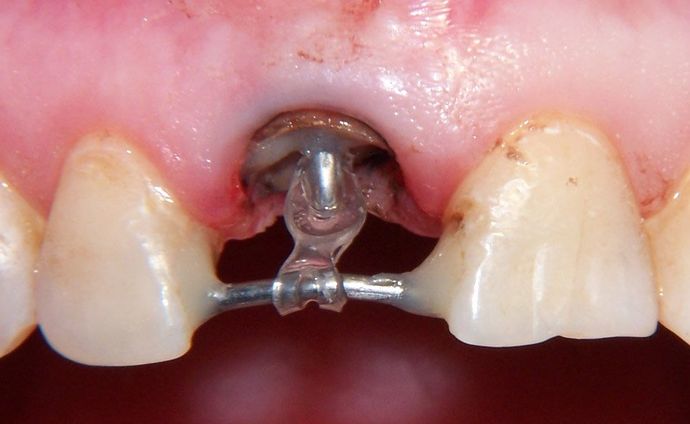
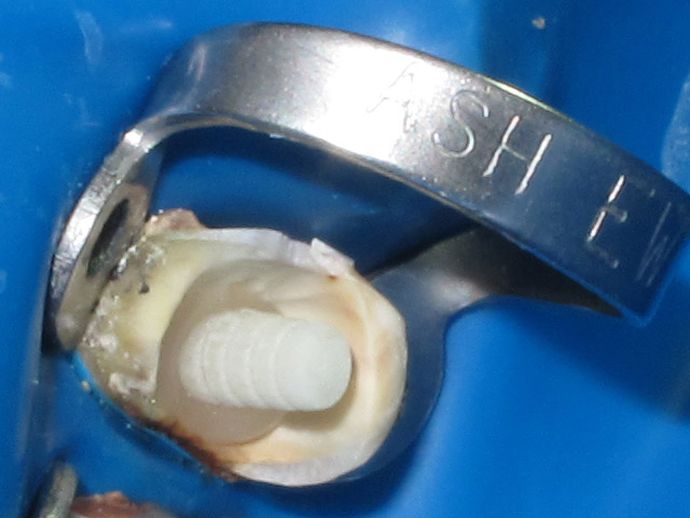
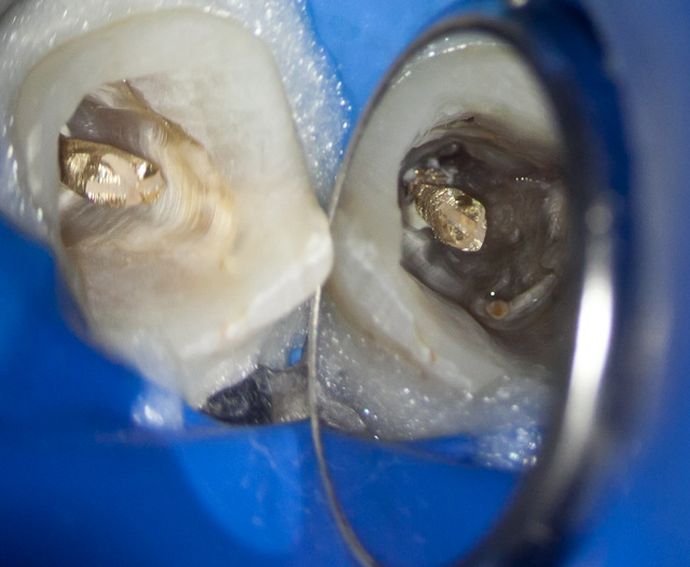
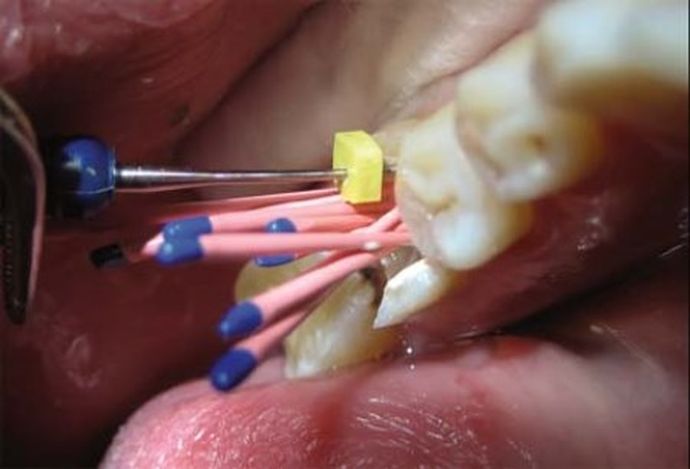
Tooth decay has not been a problem for dentists for a long time. In this case, it is not necessary to remove the root and place an implant. If the tooth is at least partially preserved, it can be restored using a pin. This design allows you to increase new tooth or put a crown, while returning it to its original functionality and appearance. Pin technology is not complicated and quite reliable, so it is often used to solve dental problems.
Navigation
What is a pin
A pin is a small, durable, rod-shaped structure that is inserted into the dental canal. Outwardly, it looks like a nail or bolt with a thread and a head. It is made of various materials, but mainly metal. Serves as a retainer and holder for an artificial tooth. Used to restore severely damaged or weak teeth.
The pin is a very strong and reliable support for removable and fixed prosthetic structures. It is inserted directly into the tooth canal and is well fixed in the bone. Thanks to this, the artificial tooth does not collapse, does not break, and can withstand heavy loads. Usually pin are chewing teeth, which are located near the cheeks. But technology allows you to install a pin anywhere in the dentition.
The choice of pins is huge. It depends on the material, size, type of structure, and method of fixation. Pick up best option should be done by a dentist, because its reliability and durability depend on the condition of the root system and the damaged tooth as a whole. The cost of orthodontic treatment also depends on the type of pin, so the patient’s wishes are also taken into account.
Installation of a pin in a tooth is possible only if it is partially preserved. Complete destruction tooth and root requires another treatment method - implantation. The feasibility and possibility of preserving the tooth and its subsequent pinning can only be determined by a dentist or orthodontist after a thorough examination and radiography.
In what cases is it permitted and prohibited to install a pin?
Destroyed by caries or mechanical damage a tooth does not always require the installation of a pin. In some cases, restoration measures are sufficient, especially if we're talking about about the front teeth. To restore a tooth using pin technology, there must be certain strict indications, which include:
- destruction of the crown part of the tooth by more than 50%;
- the need for support for removable and fixed dentures;
- absence of the outer part of the tooth with complete preservation of the root;
- stopping subsequent tooth decay after treatment of serious carious lesions;
- tooth restoration after surgical treatment periodontal pathologies;
- saving a tooth after therapy infectious diseases oral cavity.
The pin is installed only if the tooth walls are preserved by at least 15-20% and the root thickness is at least 2 mm. If for some reason this is not possible, then alternative method recovery.
Using the pin for dental prosthetics It also has its contraindications. These include:
- serious untreated carious damage to the walls of the tooth;
- damaged or very thin tooth roots;
- impossibility of clearing dental canals to at least 1/3 of the depth;
- insufficient height of the root canal;
- granuloma and cyst of the jaw in the acute period;
- chronic periodontal pathologies;
- problems with blood clotting;
- pregnancy period;
- neuropsychiatric diseases;
- allergic reactions history of implants.
Only taking into account all the indications and contraindications is it possible to choose the right technology for treating a decayed tooth. Installing a pin involves certain restrictions that cannot be ignored by either the patient or the doctor.
Types and types of dental pins
The pin is not a stable structure; it is selected to suit the individual needs of each patient. Designed for this purpose different types pins that are indicated for a particular pathology. First of all, there are several materials for making a dental rod. Depending on this, pins are divided into two types - metal and non-metal.

Non-metallic structures are used by dentists much less often than metal ones, mainly due to high cost prosthetics.
The method of attaching and fixing the pin in the jaw plays an important role. There are two main types of pins:
- active;
- passive.
The active design implies the presence of grooves (like the threads of a bolt), thanks to which it is screwed into bone tissue. This ensures maximum reliability and immobility. This restoration method is suitable for non-expanded dental canals. When properly installed and secured, the active pin lasts for decades without moving or breaking.
Passive pins are used less frequently and are indicated for the treatment of severely damaged teeth. A large hole in the tooth will not support an active structure, so a passive one is used. It involves filling the cavity with cement into which a pin is inserted. Installation is simple and quick, but less reliable and durable.
The appearance and shape of the dental post also varies. The most popular and popular conical and cylindrical designs, which are considered standard. But in different situations You may need to select a more exclusive form. For such a case, cylindrical and screw pins were invented. The choice depends on the characteristics of the channel and the size of the hole.
IN separate group There are individual pins, which are made in a single copy for a specific person. Such a knitting needle exactly follows all the bends and expansions of the dental canal, ensuring reliable fastening of the crown.
What are the advantages and disadvantages of pins?
For optimal choice orthodontic design It is necessary to weigh all the pros and cons of installing a pin in the tooth. After all, you'll have to live with it for many years, preferably without discomfort and any complications.
A tooth that is more than half destroyed cannot be restored or filled, especially if it is chewable. In this case, the only way out is complete removal and placement of the implant. But dentistry has come up with an ideal alternative to both operations - a pin tooth. It is less painful, less time-consuming and much more economical. This is the main advantage of the pin.
But this is not all the advantages. In addition to saving a hopeless tooth, pins:
- do not damage or violate the integrity of neighboring teeth;
- suitable for installation anywhere in the dentition;
- allow you to restore a damaged tooth almost from scratch, returning it to its original appearance;
- have a long service life - from 10 to 20 years;
- are made from different materials, which allows you to choose for each individual case;
- withstand heavy loads when chewing food;
- completely restore the functionality of a damaged tooth.
Like any dental structure, pins have some disadvantages. After constant significant loads, they can gradually destroy the tooth root and crown, which will ultimately lead to its complete removal. The inelasticity of some materials contributes to this. Sometimes caries develops around the knitting needle, which cannot be seen during examination. This situation is excluded if the installation was carried out efficiently and professionally.
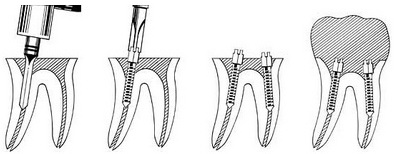
Very rarely, a pin can cause an allergic reaction followed by rejection. In this case, you will have to remove it and replace it with another material or install an implant. And, of course, the price for installing a pin is not small, so you need to be prepared for significant expenses. Although, beautiful smile and the lack of discomfort are worth it.
In any case, the advantages of the pins are much greater than the disadvantages. And the selection of a tooth restoration method remains up to the doctor. In most cases it all depends on specific situation and the severity of the dental problem. Trust professionals who know what is best for your teeth.
What are the complications?
Correct, professional, careful installation of the pin into the tooth almost 100% guarantees the absence unpleasant consequences. But in some cases they can still be. In the first days after treatment, pain, swelling and redness of the periodontal tissues may persist. Such a reaction to surgery quite normal, especially if nerves have been removed. You can take painkillers and apply cool compresses with outside. If symptoms persist long time and grow, you need to see a doctor.
Periodontitis is a complication after dental manipulation of a tooth, accompanied by inflammation and cyst formation. This is possible if the doctor made mistakes during prosthetics, for example, poorly sealed the canals, or screwed the knitting needle in incorrectly. Sometimes the cause of the disease lies in improper oral hygiene by the patient himself. You should not brush your teeth only on the first day after surgery, but then it is necessary and important to do so. Otherwise, bacteria accumulate on the mucous membrane, which leads to infection of the pin tooth. At the first signs of periodontitis, you should immediately visit the dentist and undergo an x-ray.
The most serious complication pin rejection is considered due to a hypersensitivity reaction to foreign body. This happens extremely rarely, but it does happen. The first symptoms appear already in the first days after tooth restoration. There is severe pain, inflammatory process, stomatitis develops, body temperature rises, worsens general condition. The only way out in this case is to remove the pin and replace it with a knitting needle made of a different material. Alternative option may involve complete tooth extraction and placement of an implant.
Modern technologies and materials, as well as the professionalism of the dentist, make it possible to painlessly install a pin and completely restore the tooth. Complications after treatment are rare, in exceptional cases.
Cost of installing a pin in a tooth
Beautiful smile and healthy teeth- not a cheap pleasure. Using a pin, a damaged tooth is restored with full restoration its functionality. Accordingly, such an event costs money. But there is no need to be scared in advance; the final price of a pin tooth depends on many factors.
First of all, the cost is affected by the material and type of construction. A fiberglass pin will cost the most - about 1,500 rubles. The most economical and at the same time reliable option– metal knitting needle. Its cost varies between 500-700 rubles. A custom-made one will cost more, but such a pin is guaranteed to fit a specific tooth.
The cost of treatment also depends on the number of damaged teeth. The more pins you need to insert, the higher the final price. Additionally, you will have to pay for the removal of nerves, cleaning of the canals, x-rays and the actual work of the dentist or orthodontist.
Installing a pin is the best option for saving a tooth and maintaining a beautiful, and most importantly healthy, smile for many years.
![]()
The cement secures the pin into the root of the tooth.
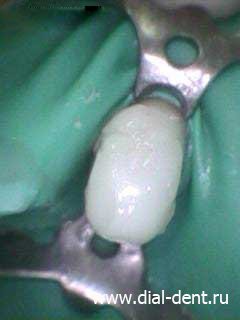
A so-called stump is molded from the restoration material on a pin - the basis for the future crown.
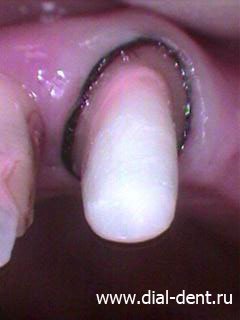
The final view of a tooth prepared for a crown. The tooth is ground with a shoulder, which makes it possible to make a higher-quality and durable metal-ceramic structure. You can read more about this in the section “ Metal ceramics
».
The dark rim around the tooth is a special retraction thread that is placed between the gum and tooth in order to move the gum back and prevent injury to the gum by the bur.
Strengthening a severely damaged tooth for a crown using a collapsible individual pin
An elderly patient contacted the Family dental center"Dial-Dent" to the chief physician Tsukor S.V. with complaints of pain under the crown.
After the examination, a diagnosis was made - inflammation of the nerve (pulpitis) in the sixth tooth upper jaw. Under removed crown It turned out to be a badly damaged tooth. All non-viable tooth tissues were removed, the canals were treated with their complete sterilization and filling using the Termofill system. Before installing a new crown, it was necessary to resolve the issue of strengthening the root, since this tooth will be a load-bearing tooth for an extended bridge structure. The solution is to install a collapsible individual pin insert made of the same alloy that will be used for the metal-ceramic bridge prosthesis.
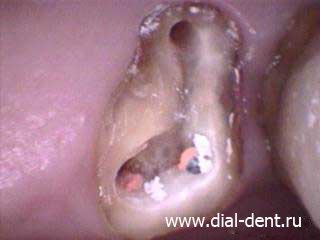
After preparation, two channels are visible under the tab, into which the pins of the collapsible tab will go.
Only one root remains from the tooth. A thermophile is visible in one of the canals, which was used to fill the canals.
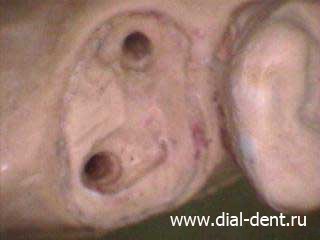
A root model is made from plaster. On this model, the dental technician will make a collapsible post stump tab.
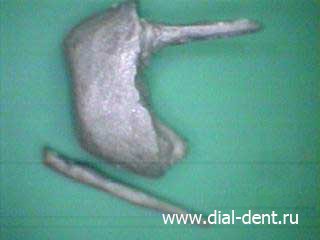
Disassembled pin stump insert. The base on which the future crown will be placed is monolithic with one of the pins. The second pin is made so that it passes through the crown base and goes into the tooth canal, not parallel to the first pin. Due to this, the insert stands as if in a spacer, which makes it stronger and distributes the chewing load on the roots more correctly, reducing the risk of root splitting.
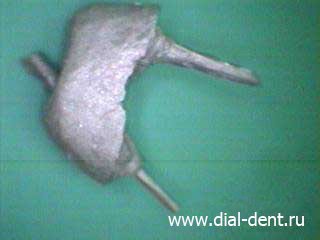
Dismountable pin stump inlay in assembled form. It is clearly seen that the multidirectionality of the pins does not allow installing this tab on the tooth in assembled form.
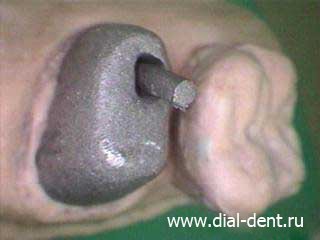
The inlay is installed on a plaster model for testing.
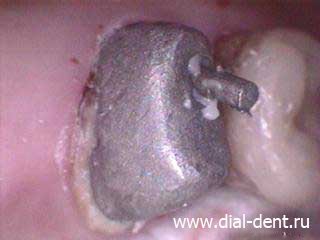
The inlay is cemented to the root of the tooth. After the cement has hardened, the protruding end of the pin is sawed off.
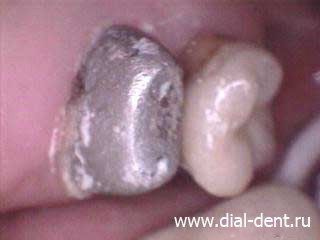
The tab is finally installed. Now you can attach the crown to it.
The only disadvantage of this design is that after the cement hardens, it is impossible to remove it from the tooth. If a doctor installs a collapsible pin stump inlay, he must be sure that the canals are treated correctly and there will be no complications in the canals, that is, the inlay will not have to be removed.
A tooth pin is a special rod that is installed in the dental canal and helps strengthen the structure of a significantly damaged tooth.
If the damage is severe, then a rod is often the only option for restoring the tooth. After such restoration, the teeth are called pinned.
There are two types of materials for making rods:
- metal;
- metal-free.
Non-metallic materials are usually:
- ceramics;
- carbon fiber;
- fiberglass.
A pin is a dental element in the form of a spoke, it is used for fastening a completely or partially destroyed tooth in the canals. The use of this element allows you to restore a tooth or prepare it for further installation of a crown.
TO metal materials include:
- stainless steel;
- titanium;
- palladium;
- brass;
- gold.
Types of pins
Dentists use different types designs, depending on each specific case. They differ in their shape, composition, as well as installation features:
- Standard dental pin of cylindrical or conical shape. Typically, such products are used for small scale destruction.
- Fiberglass products.
Attention! The fiberglass pin is elastic and also resistant to saliva and does not affect existing prostheses. Such pins are invisible; they do not show through tooth tissue, fillings or crowns. ×
Fiberglass rods are an alternative to metal rods.
- Metal pins. They are used in case of severe tooth decay and make it possible to reliably strengthen the part to be restored.
- Carbon fiber structures. Rods made from this material are considered the most modern. They are the most durable and have the ability to distribute the load on the tooth well. Such products have maximum medicinal benefits and provide excellent results.
- Anchor pins. Such rods are made of titanium alloy. This type of restoration is also very reliable and is one of the the best options tooth restoration.
- Individual rods. Such products are made for a specific patient, taking into account the characteristics of his teeth. This pin is reliable, perfectly fixed at the root.
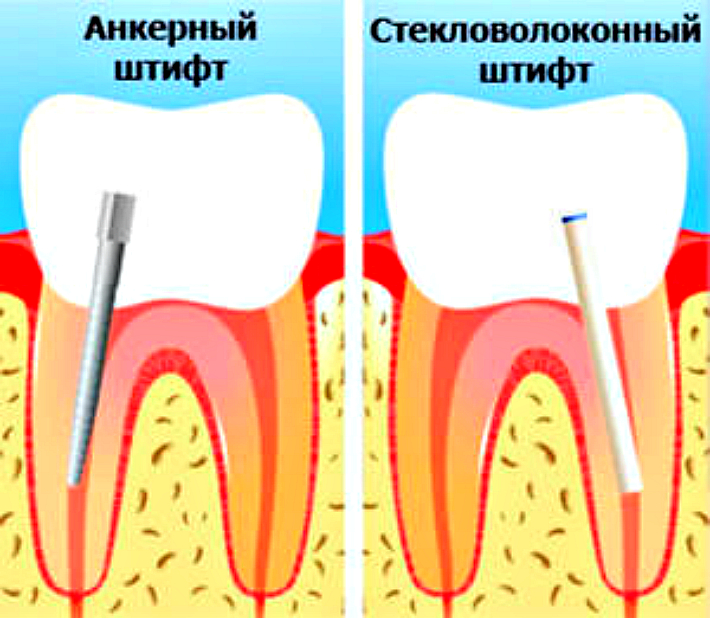
The pin in the tooth is used as a basis for tooth restoration using composite materials. Its use makes it possible to speed up and facilitate restoration work. The use of a pin removes restrictions on the load on the restored tooth.
The pins are divided depending on their shape into:
- conical;
- cylindrical;
- screw;
- cylindrical-conical.
Types of rods by fixation method:
- passive;
- active.
A passive dental post is fixed in the canal using a special material. This system is used to strengthen the tooth after treatment.
Attention! Active pins are fixed in dentin tissues. The rod is threaded and literally screws into the bone tissue. This method of installation is very reliable and allows you to restore even a tooth after severe damage. ×
The disadvantage of such a rod is the stress it creates, which can cause cracks and splits.
Pin selection
IN dental practice rods are used to restore a badly damaged tooth, as well as to attach a prosthetic structure to the root.
Important! The choice of pin is made taking into account the degree of tooth decay, as well as in accordance with the financial capabilities and desires of the patient. The dentist will help you make the final decision. ×
The specialist gives preference to one or another product, taking into account following points:
- Condition of the root and its walls. These parameters determine the depth of the rod placement.
- Estimated load after treatment. The tooth may be chewable, stand alone, or be part of a denture. All these factors must be taken into account.
- The patient's health status and possible allergic reactions. These aspects determine the material of the product as well as the appropriate installation technique.
- The level of destruction of the tooth crown relative to the gums and root.
IN lately There is a tendency towards the preferred choice of rods made of non-metallic material. They are more convenient to use and have wide range medicinal properties. For example, fiberglass products are ideally fixed, tightly filling the root canals. Also, fiberglass has good aesthetic characteristics and can be used to restore a tooth with filling material without installing a prosthesis. Such a pin does not shine through the filling and does not react with it.





